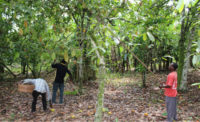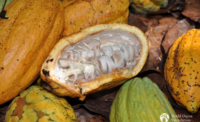Mighty Earth report blames West African deforestation on cocoa industry
World Cocoa Foundation president cites Cocoa & Forests Initiative effort, noting action plan will “double down” on ending deforestation.

Deforestation begins when settlers clear the underbrush of forests by cutting down or burning existing trees, leaving trunks denuded of their crowns and leaves. Photo courtesy of Mighty Earth.
In a just released report titled “Chocolate’s Dark Secret,” Mighty Earth, a global environmental campaign organization, claimed that 90 percent of protected national parks in the Ivory Coast have been deforested for growing cocoa while Ghana was undergoing a similar process.
The deforestation in the Ivory Coast has also driven chimpanzee populations “into just a few small pockets, and reduced the country’s elephant population from several hundred thousand to about 200-400,” the group asserted.
“In the world’s two largest cocoa producing countries, Ivory Coast and Ghana, the market created by the chocolate industry has been the primary driver behind the destruction of forests,” the report said.
The authors, however, admit that the world’s largest chocolate companies have begun to publicly address deforestation, noting that 34 leading companies joined Prince Charles earlier this year to come up with a plan by November at the UN’s Climate Change Conference in Germany.
Rick Scobey, president of the World Cocoa Foundation, acknowledged that deforestation has been a “well-known problem” in West Africa.
“The industry has been focused on ending deforestation and forest degradation in the global supply chain for several years,” he said. “Many individual companies have been working with farmers on the ground to strengthen sustainable land use in cocoa production. We know that sustainable cocoa is too big a challenge for any one company to address. That is why we launched the industry-wide Cocoa and Forests Initiative this year in partnership with the governments to drive change at the global scale.”
He cited the Cocoa and Forest Initiative as key to ending deforestation.
“Our first goal was to come together as an industry and agree to a statement of initiatives,” he explained. “The second phase during the next five to six months involved rolling up our sleeves and mapping out a detailed framework of steps and milestones. We are focusing on key issues such as restrictions on production and sourcing of cocoa in forest areas, restoration of degraded forests, boosting agricultural productivity in environmentally suitable areas, and improved monitoring of the origin of cocoa production at the farm level. We are on track to present a strong Framework for Action at the Climate Change conference in Bonn in November.”
Scobey said the industry/government partnership involves “shared accountability.” As the WCF executive outlines, the first step involves restricting any new conversion of any existing forest land for cocoa farming. Then there’s a pressing need for “sustainable agricultural intensification in environmentally suitable areas,” which would relieve pressure for further encroachment into forests.
“Our goal is ‘more cocoa from less land,’” Scobey said.
Finally, he cited the importance of “protecting both people and the planet. Efforts to end deforestation must respect the rights of the thousands of cocoa farmers and their families whose lives depend on the forests. We must minimize adverse social and economic impacts on communities and ensure that farmers who currently grow cocoa in protected areas are provided with viable alternative sources of income.”
Scobey said he was both “excited and optimistic” about the joint progress the Cocoa & Forests Initiative has already made. However, he was also realistic about the effort needed in the months ahead, which involves finalizing a Framework for Action and mobilizing financing.
Nonetheless, he’s remains impressed with the “passion and commitment” from the cocoa industry toward sustainability.




